Selection of Optimal Polymerization Degree and Force Field in the Molecular Dynamics Simulation of Insulating Paper Cellulose
Abstract
:1. Introduction
2. Selection of the Polymerization Degree of Cellulose Models
2.1. Models Building
2.2. Parameters Setting
2.3. Analysis of Mechanical Properties
2.4. Solubility Analysis
3. Study on Force Field Selection for Cellulose Modeling
3.1. Models Building and Parameters Setting
3.2. Analysis of Steady-State Density
3.3. Analysis of Repeatability and Volatility
4. Conclusions
- (1)
- When the DP of the model was less than 10, the model is inconsistent with the polysaccharide properties of cellulose. When DP exceeded 10, the results conformed to the actual mechanical and chemical properties of cellulose. Therefore, the polymerization degree of the model constructed for molecular dynamics simulation of cellulose should not be less than 10.
- (2)
- The steady-state density of cellulose obtained using the COMPASS force field was closer to the actual density of cellulose than that determined using the PCFF force field. Analysis from the perspectives of repeatability and volatility revealed that good discreteness of the mechanical properties of the model, concentrated data, and small volatility were obtained using the COMPASS force field. Therefore, the COMPASS force field is better than the PCFF force field for cellulose molecular dynamics simulation.
Acknowledgments
Author Contributions
Conflicts of Interest
References
- Wang, X.; Xiao, S.B.; Zhang, Z.L.; He, J.Y. Effect of Nanoparticles on Spontaneous Imbibition of Water into Ultraconfined Reservoir Capillary by Molecular Dynamics Simulation. Energies 2017, 10, 506. [Google Scholar] [CrossRef]
- Niall, J. Massively-Parallel Molecular Dynamics Simulation of Clathrate Hydrates on Blue Gene Platforms. Energies 2013, 6, 3072–3081. [Google Scholar]
- Han, H.H. Research on Transformer Aging Character and Analysis Aging Mechanism. Ph.D. Thesis, Changsha University of Science and Technology, Changsha, China, 2010. [Google Scholar]
- Lu, X.; Han, S.; Li, Q.M.; Wang, X.L.; Wang, G.Y. Reactive Molecular Dynamics Simulation of Polyimide Pyrolysis Mechanism at High Temperature. Trans. China. Electrotech. Soc. 2016, 31, 15–20. [Google Scholar]
- Deng, S.W.; Huang, Y.M.; Liu, H.L.; Hu, Y. Computer Simulation of Mechanical Properties of Polymer Materials. CIESC J. 2015, 66, 2768–2770. [Google Scholar]
- Miyamoto, H.; Rein, D.; Ueda, K.; Yamane, C.; Cohen, Y. Molecular Dynamics Simulation of Cellulose-coated Oil-in-water Emulsions. Cellulose 2017, 24, 2699–2711. [Google Scholar] [CrossRef]
- Reid, M.; Villalobos, M.; Cranston, E. The Role of Hydrogen Bonding in Non-ionic Polymer Adsorption to Cellulose Nanocrystals and Silica Colloids. Curr. Opin. Colloid Interface Sci. 2017, 29, 76–82. [Google Scholar] [CrossRef]
- Tang, C.; Zhang, S.; Wang, Q.; Wang, X.B.; Hao, J. Thermal Stability of Modified Insulation Paper Cellulose Based on Molecular Dynamics Simulation. Energies 2017, 10, 397. [Google Scholar] [CrossRef]
- Kono, H.; Ogasawara, K.; Kusumoto, R.; Oshima, K.; Hashimoto, H.; Shimizu, Y. Cationic Cellulose Hydrogels Cross-linked by Poly(ethylene glycol): Preparation, Molecular Dynamics, and Adsorption of Anionic Dyes. Carbohydr. Polym. 2016, 152, 170–180. [Google Scholar] [CrossRef] [PubMed]
- Berglund, J.; Angles, D.; Vilaplana, F. A Molecular Dynamics Study of the Effect of Glycosidic Linkage Type in the Hemicellulose Backbone on the Molecular Chain Flexibility. Plant J. 2016, 88, 56–70. [Google Scholar] [CrossRef] [PubMed]
- Mazeau, K.; Heux, L. Molecular Dynamics Simulations of Bulk Native Crystalline and Amorphous Structures of Cellulose. J. Phys. Chem. B 2003, 107, 2394–2403. [Google Scholar] [CrossRef]
- Paajanen, A.; Vaari, J. High-temperature Decomposition of the Cellulose Molecule: A Stochastic Molecular Dynamics Study. Cellulose 2017, 24, 2713–2725. [Google Scholar] [CrossRef]
- Zhu, M.Z. Molecular Dynamics Study of Thermal Aging of Oil-impregnated Insulation Paper. Ph.D. Thesis, Chongqing University, Chongqing, China, 2012. [Google Scholar]
- Zhang, X.M.; Mark, A. Mechanical Properties of Amorphous Cellulose Using Molecular Dynamics Simulations with a Reactive Force Field. Int. J. Model. Identif. Control 2013, 18, 211–217. [Google Scholar] [CrossRef]
- Matthews, J.F.; Bergenstrahle, M.; Wohlert, J.; Brady, J.W.; Himmel, M.E.; Crowley, M.F. Simulations of Cellulose Microfibrils with Several Molecular Mechanics Force Fields; American Chemical Society: Washington, DC, USA, 2010. [Google Scholar]
- Mostofian, B.; Cheng, X.; Smith, J.C. Replica-exchange Molecular Dynamics Simulations of Cellulose Solvated in Water and in the Ionic Liquid 1-butyl-3-methylimidazolium Chloride. J. Phys. Chem. B 2014, 118, 11037–11049. [Google Scholar] [CrossRef] [PubMed]
- Liu, C.; Jiang, D.Z.; Wei, S.A.; Huang, J.B. A Study of Thermal Decomposition in Cellulose by Molecular Dynamics Simulation. Nat. Sci. 2009, 1, 41–46. [Google Scholar] [CrossRef]
- Huang, J.B.; Liu, C.; Wei, S.A.; Fan, X.; Jiang, D.Z. Molecular Simulation of Pyrolysis Mechanism of Cellulose and Analysis of Formation Paths of Major Products. J. Chongqing Univ. 2010, 33, 65–69. [Google Scholar]
- Huang, R.; Yao, W.S.; Tan, H.M. Molecular Simulation of Cellulose-based Energetic Binders. Chin. J. Explos. Propellants 2008, 31, 64–67. [Google Scholar]
- Zhang, X.M.; Shi, S.Q.; Cao, J. Elastic Properties of Cellulose by Molecular Dynamics Simulation. Appl. Mech. Mater. 2013, 416–417, 1726–1730. [Google Scholar] [CrossRef]
- Chen, W.; Lickfield, G.C.; Yang, C.Q. Molecular modeling of cellulose in amorphous state. Part I: Model building and plastic deformation study. Polymer 2004, 45, 1063–1071. [Google Scholar] [CrossRef]
- Bazooyar, F.; Momany, F.A.; Bolton, K. Validating Empirical Force Fields for Molecular-level Simulation of Cellulose Dissolution. Comput. Theor. Chem. 2012, 984, 119–127. [Google Scholar] [CrossRef]
- Berendsen, H.J.C.; Postma, J.P.M.; Funsteren, W.F. Molecular dynamics with coupling to an external bath. J. Chem. Phys. 1984, 81, 3684–3690. [Google Scholar] [CrossRef]
- Andrea, T.A.; Swope, W.C.; Andersen, H.C. The role of long ranged forces in determining the structure and properties of liquid water. J. Chem. Phys. 1983, 79, 4576–4584. [Google Scholar] [CrossRef]
- Lu, Y.C. The Aging Mechanism and Gas Diffusion Behavior Research in Molecular Simulation of Oil Paper Insulation. Ph.D. Thesis, Chongqing University, Chongqing, China, 2007. [Google Scholar]
- Zhang, S.; Tang, C.; Wang, X.B.; Hao, J. Thermal stability and dielectric property of nano-SiO2-doped cellulose. Appl. Phys. Lett. 2017, 111, 012902. [Google Scholar] [CrossRef]
- Liao, R.J.; Zhu, M.Z.; Yang, L.J. Molecular dynamics study of water molecule diffusion in oil-paper insulation materials. Phys. B Condens. Matter 2011, 406, 1162–1168. [Google Scholar] [CrossRef]
- Liao, R.J.; Zhang, F.Z.; Yuan, Y. Preparation of a dicyandiamide contained novel insulation paper and an experiment on the thermal aging characteristics of reel oil-paper insulations. J. Chongqing Univ. 2013, 36, 47–51. [Google Scholar]
- Nie, S.J. Molecular Simulation Study on Oxidation and Hydrolysis of Amorphous Region of Cellulosic Insulation Paper in Power Transformer. Ph.D. Thesis, Chongqing University, Chongqing, China, 2013. [Google Scholar]
- Tang, C.; Zhang, S.; Li, X. Molecular dynamics simulations of the effect of shape and size of SiO2 nanoparticle dopants on insulation paper cellulose. AIP Adv. 2016, 6, 125106. [Google Scholar] [CrossRef]
- Hak, L.L.; Philip, L. The Solubility Parameter of Cellulose and Alkylketene Dimer (AKD) Determined by Inverse Gas Chromatography. J. Wood Chem. Technol. 1991, 45, 1063–1071. [Google Scholar]
- Rowe, R.C. The prediction of compatibility/incompatibility in blends of ethyl cellulose with hydroxypropyl methylcellulose or hydroxypropyl cellulose using 2-dimensional solubility parameter maps. J. Pharm. Pharmacol. 1986, 38, 214–215. [Google Scholar] [CrossRef] [PubMed]
- Mark, H.F. Encyclopedia of Polymer Science and Technology, 2nd ed.; John Wiley & Sons, Inc.: New York, NY, USA, 1982; pp. 35–68. [Google Scholar]
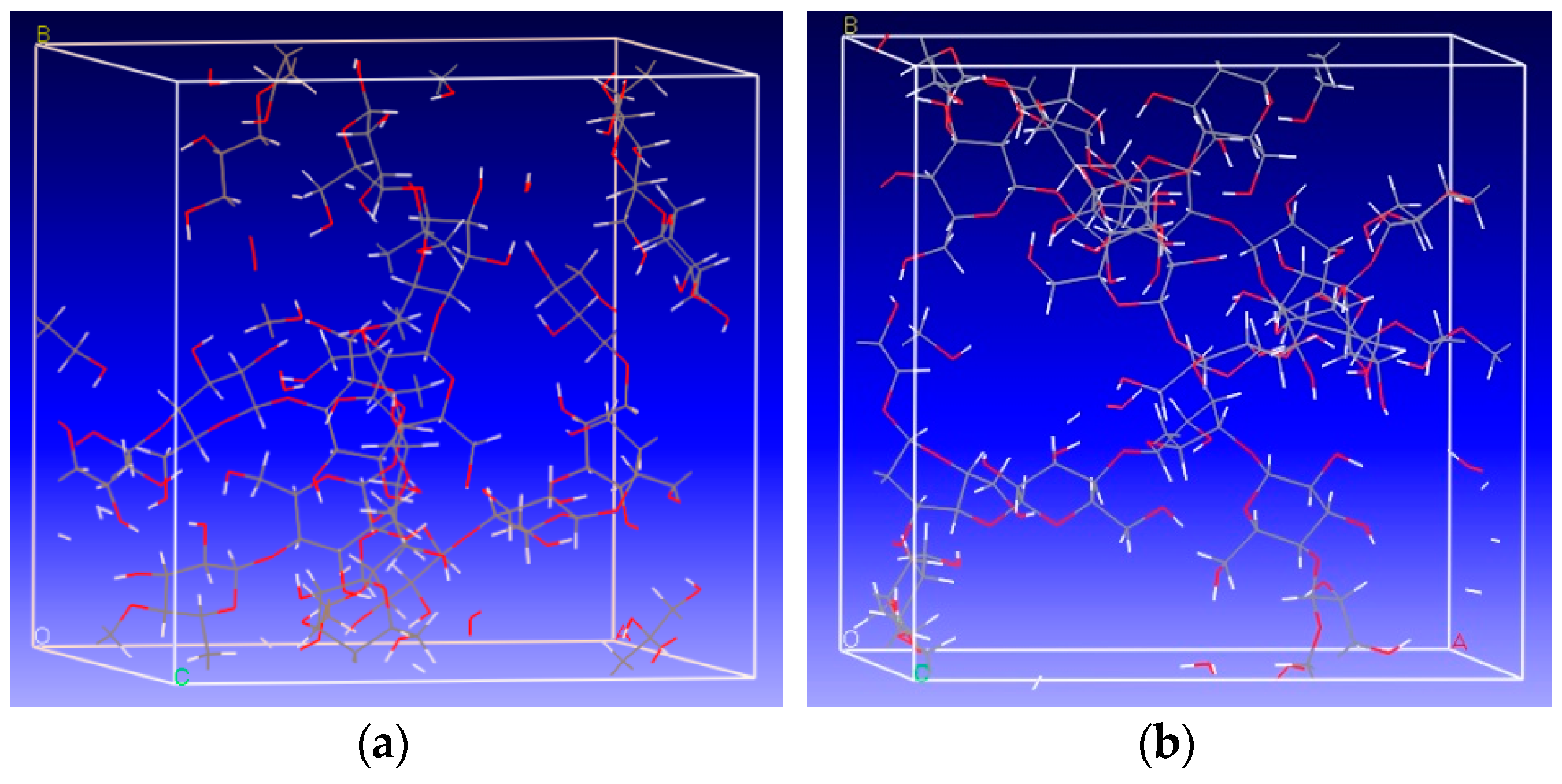
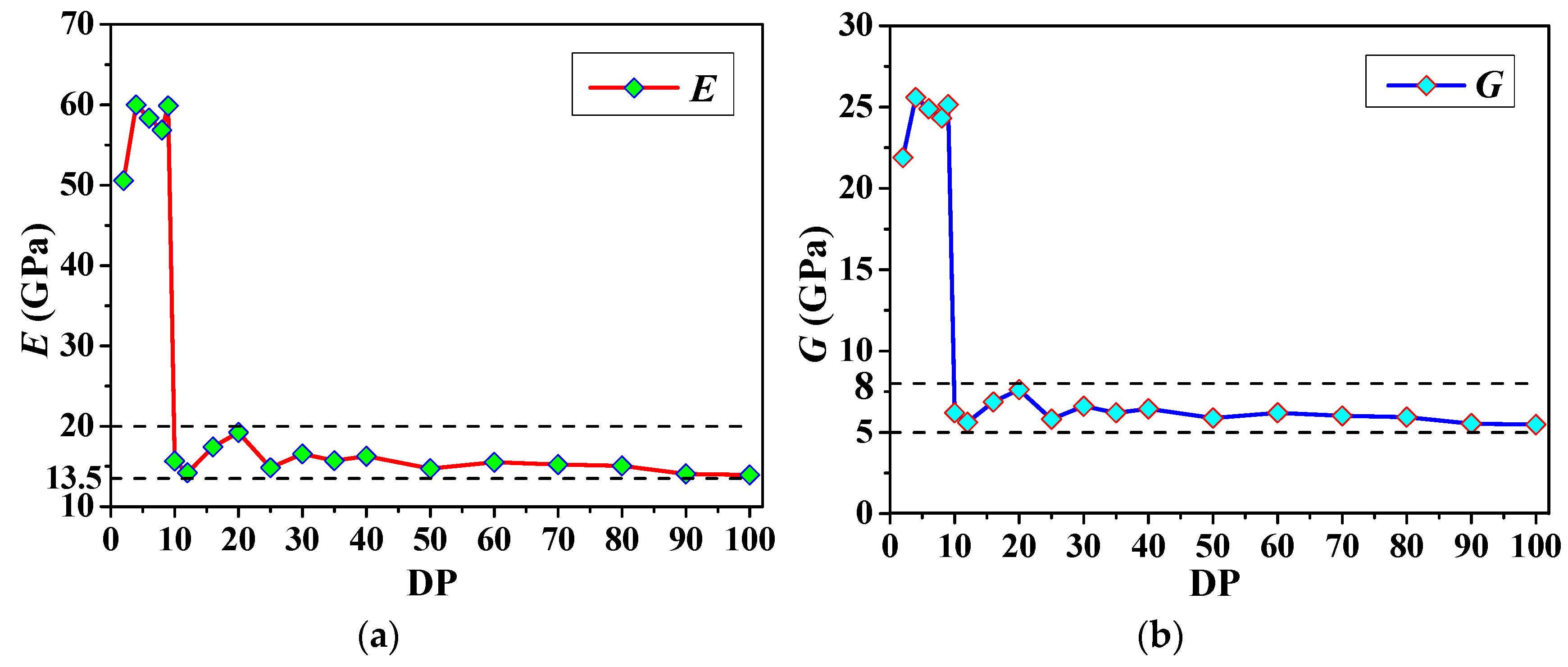


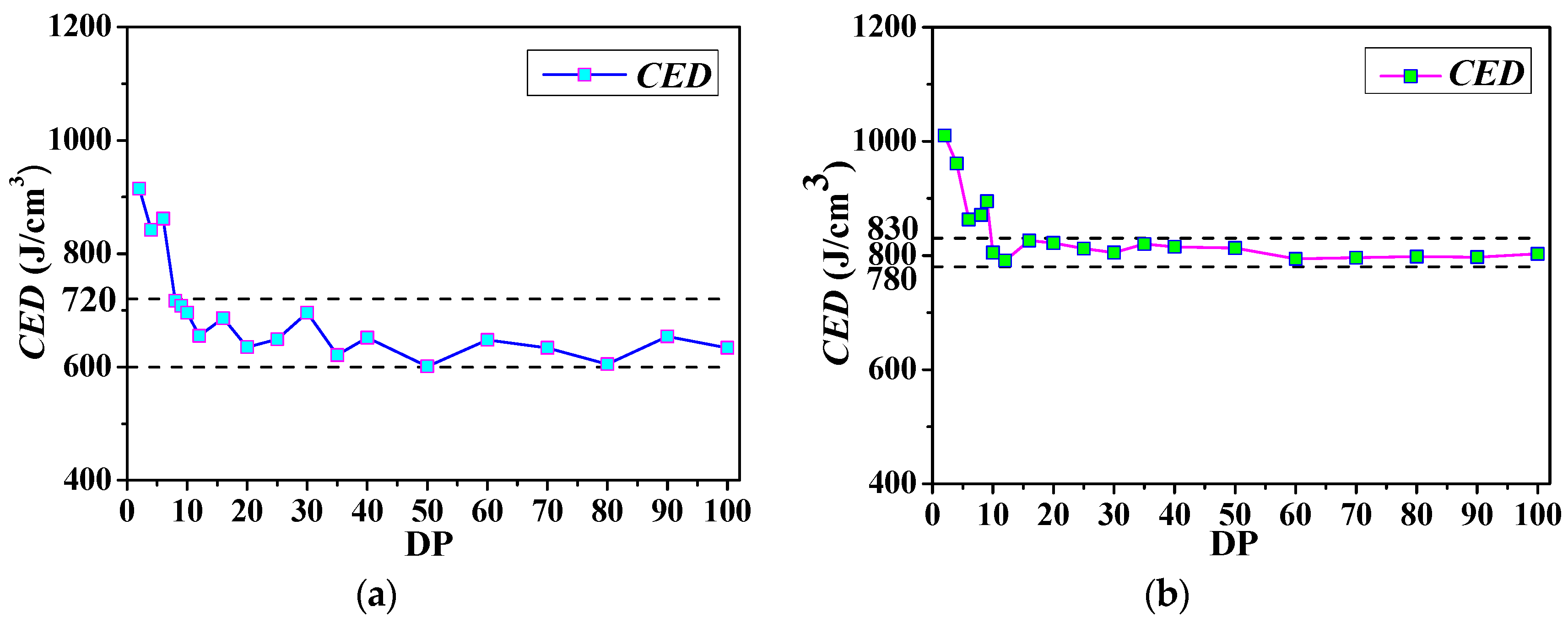
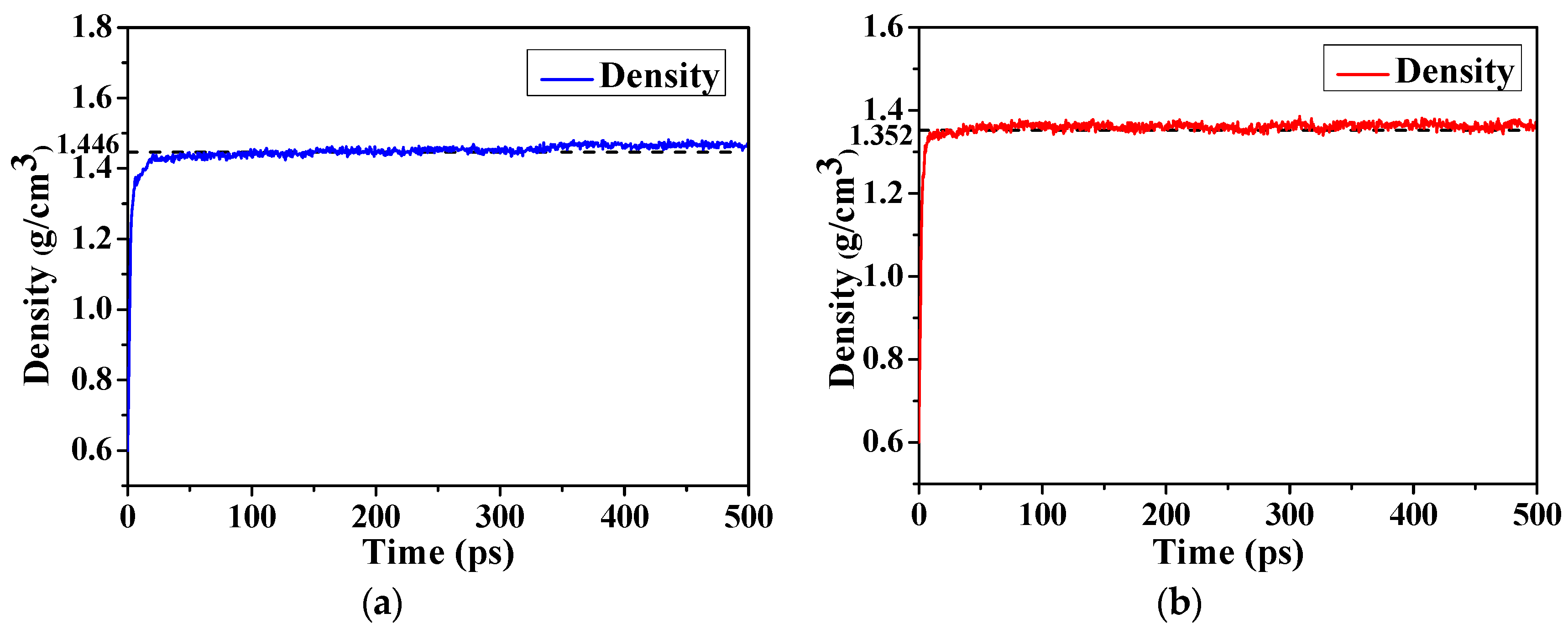
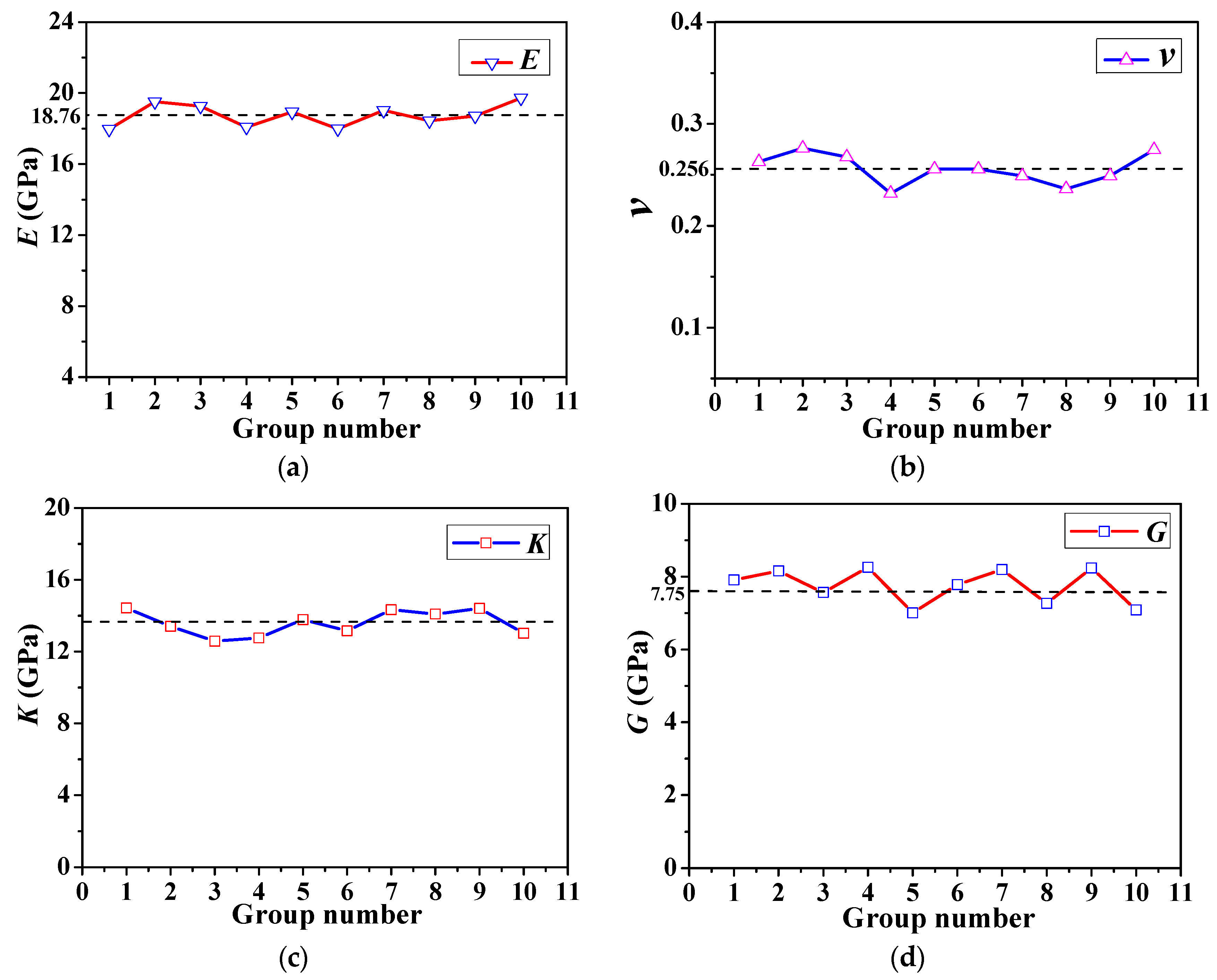
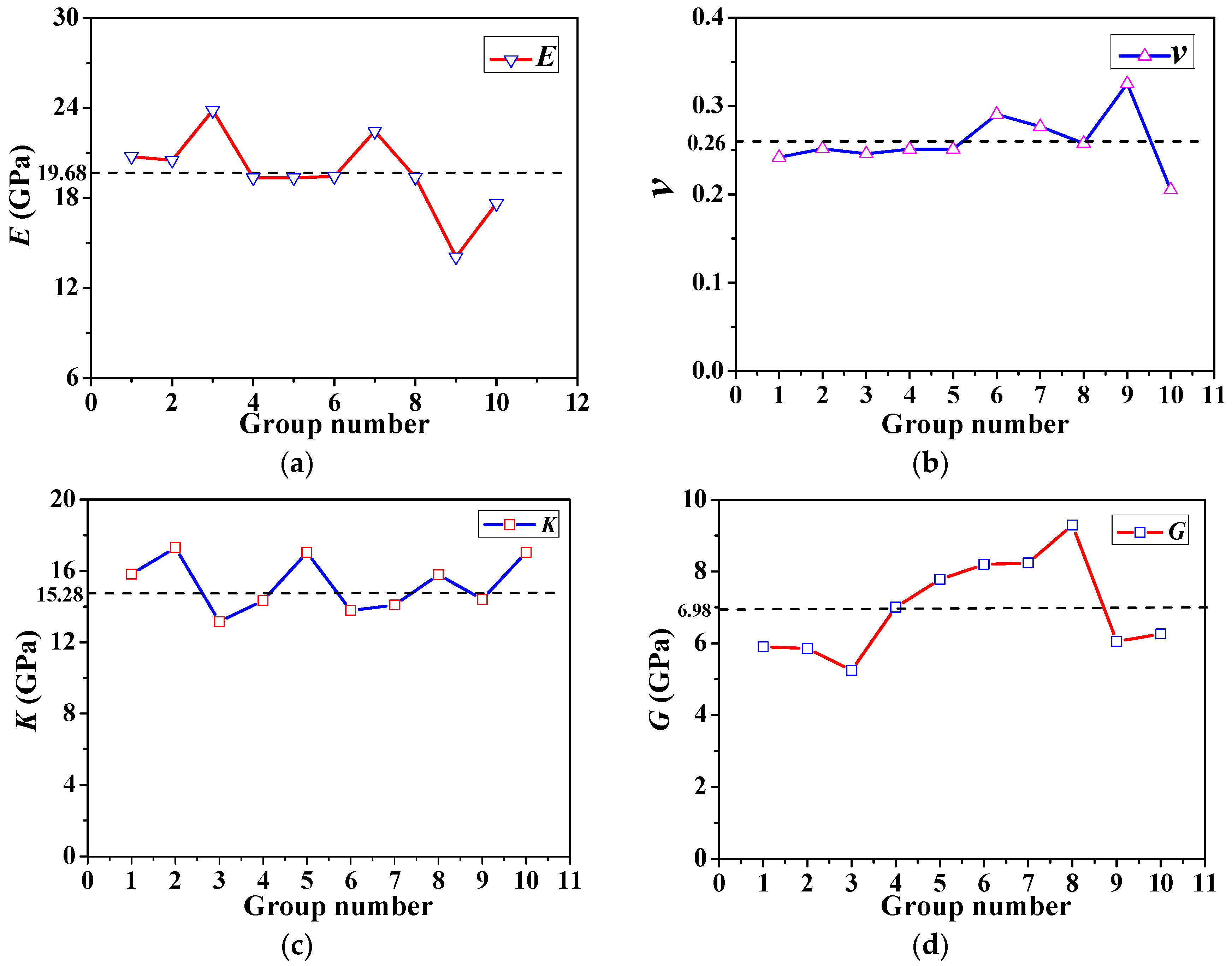
| COMPASS | PCFF | ||||||
|---|---|---|---|---|---|---|---|
| E | G | v | C12-C44 | E | G | v | C12-C44 |
| 14.568 | 5.766 | 0.248 | 0.143 | 17.939 | 6.890 | 0.276 | 0.118 |
| DP | 10 | 20 | 30 | 40 | 50 | 60 | 70 | 80 | 90 | 100 | Average |
|---|---|---|---|---|---|---|---|---|---|---|---|
| COMPASS | 26.4 | 25.6 | 25.3 | 25.4 | 24.9 | 25.5 | 25.2 | 25.6 | 24.6 | 25.2 | 25.4 |
| PCFF | 28.4 | 28.1 | 28.7 | 28.4 | 28.5 | 28.2 | 28.3 | 28.2 | 28.5 | 28.3 | 28.4 |
| COMPASS | PCFF | ||||||||||
|---|---|---|---|---|---|---|---|---|---|---|---|
| 1 | 2 | 3 | 4 | 5 | Average | 1 | 2 | 3 | 4 | 5 | Average |
| 1.41 | 1.43 | 1.47 | 1.47 | 1.45 | 1.446 | 1.36 | 1.34 | 1.35 | 1.31 | 1.40 | 1.352 |
| COMPASS | PCFF | |||||
|---|---|---|---|---|---|---|
| Parameter | μ | s | β (%) | μ | s | β (%) |
| E | 18.76 | 0.64 | 5.09 | 19.68 | 2.64 | 21.15 |
| v | 0.26 | 0.01 | 9.39 | 0.26 | 0.03 | 25.25 |
© 2017 by the authors. Licensee MDPI, Basel, Switzerland. This article is an open access article distributed under the terms and conditions of the Creative Commons Attribution (CC BY) license (http://creativecommons.org/licenses/by/4.0/).
Share and Cite
Wang, X.; Tang, C.; Wang, Q.; Li, X.; Hao, J. Selection of Optimal Polymerization Degree and Force Field in the Molecular Dynamics Simulation of Insulating Paper Cellulose. Energies 2017, 10, 1377. https://doi.org/10.3390/en10091377
Wang X, Tang C, Wang Q, Li X, Hao J. Selection of Optimal Polymerization Degree and Force Field in the Molecular Dynamics Simulation of Insulating Paper Cellulose. Energies. 2017; 10(9):1377. https://doi.org/10.3390/en10091377
Chicago/Turabian StyleWang, Xiaobo, Chao Tang, Qian Wang, Xiaoping Li, and Jian Hao. 2017. "Selection of Optimal Polymerization Degree and Force Field in the Molecular Dynamics Simulation of Insulating Paper Cellulose" Energies 10, no. 9: 1377. https://doi.org/10.3390/en10091377





